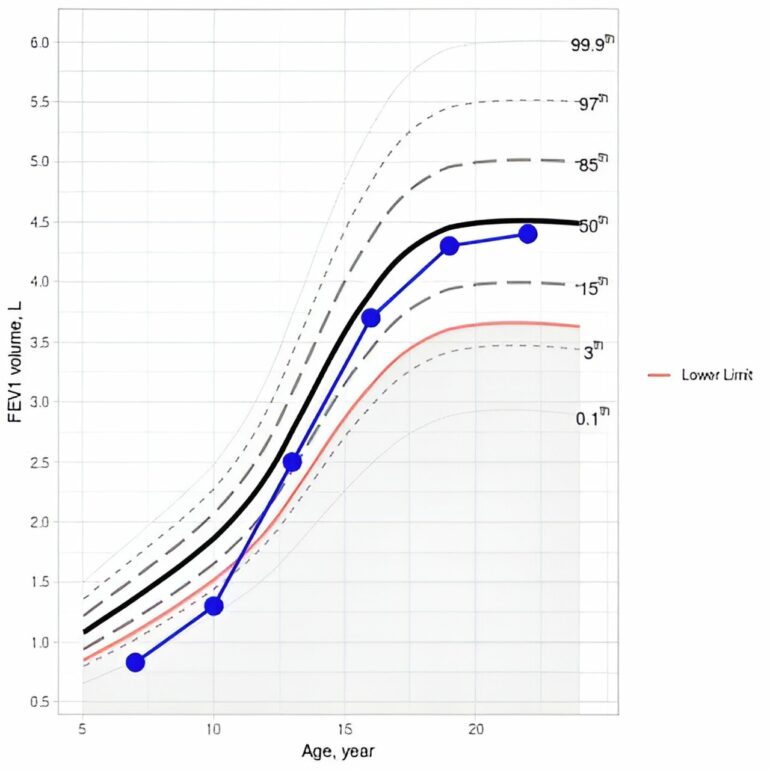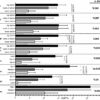Height and weight charts have been used for decades to monitor child development. A paper published in The Lancet now presents a new application that enables health care professionals to keep a regular check on the development of one of the body’s most vital organs—the lungs.
The Lung Function Tracker is the product of an international collaboration involving researchers at KI; the University of Barcelona, Spain; the Imperial College London, the U.K.; and the University of Melbourne, Australia.
How does the Lung Function Tracker work?
“Our research group and in particular Simon Kebede Merid and Gang Wang have developed a highly intuitive web-based tool. You measure lung function using a regular spirometry machine, enter the measures and personal data such as gender and age, and the Lung Function Tracker creates a graph showing the person’s lung function in relation to the expected values.
“What’s unique is that you can also monitor lung development over time, just like for the growth curves for height and weight,” says Erik Melén, professor of pediatric medicine at the Department of Clinical Research and Education, Södersjukhuset, Karolinska Institutet, and the paper’s first author.
Why is the Lung Function Tracker needed?
“Lung diseases and the disease burden they cause aren’t taken as seriously as they ought to be. The symptoms are often severe and there’s also the risk of secondary problems like cardiovascular disease and reduced life expectancy. By catching abnormal levels in someone’s lung function early, doctors will be able to give personalized treatment to stop things getting worse.”
The Lung Function Tracker is designed for optimal accessibility. What does that mean?
“This is like the growth chart of the lungs. Our aim is for the tool to be intuitive for users. It doesn’t require an account or log-in details, and it’s free to use. All you need is access to Internet and the data generated by the examination of lung function.”
“We’ve focused on creating a tool that is simple and standardized enough to encourage widespread use, not only in Sweden and Europe but around the world. Although the tool can be used by anyone, it’s intended mainly for health care professionals and patients, adults as well as children, who need to keep a check on their lung function over time as part of their self-care.”
What does your wide cooperation mean for an innovation project like this?
“We got the idea for the Lung Function Tracker after having analyzed data from the large BAMSE project when following asthma and allergy development in more than 4,000 children for a number of years. We also have many active partners in the project, including hospitals, universities, research institutes and patient organizations.”
“With such broad-based collaboration we wouldn’t have been able to develop a tool at the right level for implementation in a clinical environment without unnecessary obstacles. Our vision of the tool being used globally requires wide acceptance and engagement, and I feel we have this.”
The tool has caused something of a sensation. Tell us about it.
“We presented the Lung Function Tracker at the European Respiratory Society conference, the world’s largest lung conference, last autumn and now The Lancet has just published our paper on it. The response we’ve had shows that there’s a great demand for a tool that can catch patients in the risk zone before they develop a chronic condition. Such a check of lung function development as this is not only simple and quick, it’s also relatively cheap.”
What’s next?
“We’re now working on publicizing the tool so that more people get to hear about it. We hope that it will also help to increase knowledge and raise awareness of common chronic lung diseases, such as asthma and COPD.”
“On top of this, we’re planning to gather together experts from around the world to look into the possibility of introducing lung function check-ups at a population level, in the same way as height and weight are monitored today,” says Professor Melén.
More information:
Erik Melén et al, Lung-function trajectories: relevance and implementation in clinical practice, The Lancet (2024). DOI: 10.1016/S0140-6736(24)00016-3
Provided by
Karolinska Institutet
Citation:
Q&A: New digital tool enables monitoring of lung function over time (2024, March 13)



